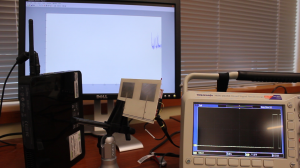 MIT Technology Review has a super article on research by professors Shyam Gollakota, Josh Smith, and David Wetherall and graduate students Bryce Kellogg and Aaron Parks:
MIT Technology Review has a super article on research by professors Shyam Gollakota, Josh Smith, and David Wetherall and graduate students Bryce Kellogg and Aaron Parks:
“Engineers have worked for decades on ways to generate power by harvesting radio signals from the air, a ubiquitous resource thanks to radio, TV, and cellular network transmitters. But although enough energy can be collected that way to run low-powered circuits, the power required to actively transmit data is significantly higher. Harvesting ambient radio waves can collect on the order of tens of microwatts of power. But sending data over Wi-Fi requires at least tens of thousands of times more power—hundreds of milliwatts at best and typically around one watt of power, says Gollakota.
“The Washington researchers got around that challenge by finding a way to have the devices communicate without having to actively transmit. Their devices send messages by scattering signals from other sources—they recycle existing radio waves instead of expending energy to generate their own.”
Read the MIT Technology Review article here. Learn more about the WiFi Backscatter project here.
UW News press release here.

